Welcome to our blog post on RAS (Recirculating Aquaculture System) Fish Farm Cost and Profit Analysis! This article will explore the economics and project report of establishing a RAS fish farm. Whether you’re a budding entrepreneur or a curious enthusiast, understanding the costs and profit potential of RAS fish farming is crucial for making informed decisions. Join us as we navigate the world of RAS fish farming economics and unlock the potential for sustainable and profitable aquaculture ventures, along with the project report of RAS fish farming below.
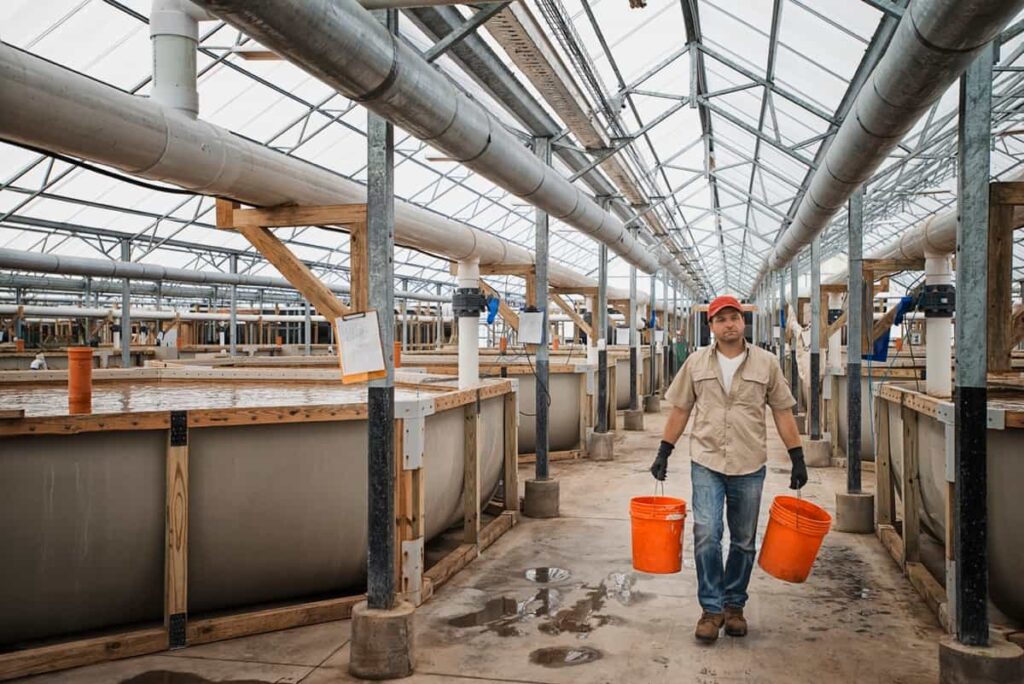
What is Recirculatory Aquaculture System (RAS)?
Recirculatory Aquaculture System (RAS) is a technology that efficiently uses water by recycling and reusing it after filtration. Unlike traditional aquaculture methods, RAS involves high-density fish culture in indoor/outdoor tanks, providing a controlled environment. Water is filtered and cleaned using mechanical and biological filters, with minimal new water added to compensate for losses.
Efficiently utilizing the system’s capacity is crucial for economic viability. The success of RAS depends on factors like feed quality, filtration type, and overall water quality. While large-scale RAS is capital-intensive, promoting Backyard Recirculation Aquaculture Systems can enable small-scale farmers and entrepreneurs in urban and semi-urban areas with limited land and water resources to engage in fish production.
How Does the Recirculatory Aquaculture System (RAS) Work?
The Recirculatory Aquaculture System (RAS) recycles and reuses water through mechanical and biological filtration processes. In RAS, water undergoes filtration to remove suspended matter, metabolites, excess nutrients, and solids, ensuring good water quality for the fish. This technology allows for high-density fish culture in tanks within a controlled environment, reducing the need for extensive land area.
Only a small amount of fresh water is added to minimize losses due to evaporation, splash-out, and waste removal. Less than 10% of the total water volume is typically replaced daily. RAS maximizes water efficiency while maintaining optimal conditions for fish growth and productivity.
In case you missed it: Project Report of Biofloc Fish Farming: Production Economics, Cost, and Profit Analysis
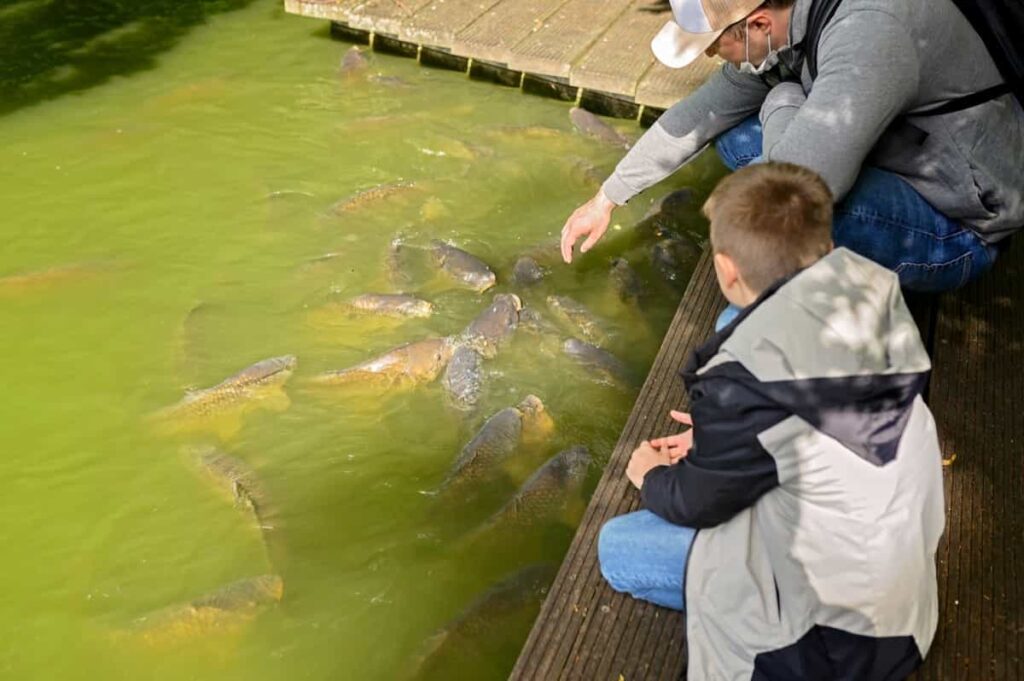
Benefits of Recirculatory Aquaculture System (RAS)
- Extended durability of tanks and equipment, resulting in long-term cost savings.
- Reduced dependency on antibiotics and therapeutic agents, leading to high-quality fish production.
- Lower direct operational costs associated with feed, predator control, and parasites.
- Potential elimination of parasite release into recipient waters, reducing environmental impact.
- Risk reduction from climatic factors, diseases, and parasites.
- Flexibility in a farm location, allowing proximity to markets.
- Capability to farm a wide range of species, regardless of temperature requirements.
- Improved feed management with 24-hour monitoring in RAS.
- Reduced stress on fish due to adverse weather, temperature conditions, pollution, and predation.
- Secure production of non-endemic species.
- Efficient utilization of water and land areas, promoting sustainability in aquaculture operations.
Disadvantage of RAS
- A continuous and uninterrupted power supply requires backup electricity in case of power failures.
- The initial capital cost of establishing a recirculating aquaculture system is higher than traditional pond or raceway systems.
Species Suitable for Recirculatory Aquaculture Systems
- Barramundi/Asian Seabass/Bhetki (Lates calcarifer)
- Cobia (Rachycentron canadum)
- Silver/Indian Pompano (Trichinotus Blochii/Trichinotus mookalee)
- Tilapia (Oreochromis niloticus)
- Pearl spot/Karimeen (Etroplus suratensis)
- Pangasius (Pangasianodon hypophthalmus)
- Rainbow Trout (Oncorhynchus mykiss) suits hilly or cold water regions.
They can thrive in high-density culture systems and exhibit good growth rates while maintaining water quality requirements. Barramundi, cobia, and pompano are popular for their taste and market demand. Tilapia is known for its resilience and adaptability. Pearl Spot and Pangasius are valued for their taste and fast growth.
Rainbow trout, with its preference for colder waters, is ideal for RAS in hilly regions. Choosing the right species for RAS is crucial for successful aquaculture ventures, considering market demand, environmental conditions, and the capability to thrive in a recirculating system.
Components of Recirculatory Aquaculture System
- Insulated shed/building: A facility that serves as a store cum office for feed and accessories, as well as housing the pump house and other system components.
- Grow-out tanks: Circular cement or FRP tanks with inlet, outlet, and major drainage for rearing fish.
- Settling tanks: Used for separating sludge from the water.
- Water storage tanks: Sump tanks for storing water and overhead tanks for maintaining water pressure.
- Mechanical filters include drum and glass wool or muslin cloth filters to remove solid particles from the water.
- Pumps and motors: Essential for circulating and maintaining water flow within the system.
- Power generator: Provides backup electricity in case of power failures.
- Sludge collectors: Used to collect settable or dissolved solids.
- Biofilters and UV units: Help in the biological filtration of water to remove excess nutrients and maintain water quality.
- Electrification: The electrical wiring and connections required for the system.
- Automatic feeders: Used to automate the feeding process in certain cases.
- Aeration system: Provides air or oxygen to the water for maintaining proper oxygen levels and a carbon dioxide trapper system (degasser).
- Water testing kit: Used to monitor and assess water quality parameters.
- Water supply system: Includes sources like bore wells to ensure a continuous water supply.
- Inputs: This includes the necessary inputs such as fish seed, feed, additives, supplements, electricity or diesel for power, and human resources.
These components collectively create an efficient RAS setup, enabling the sustainable production of fish while maintaining optimal water quality and environmental conditions.
In case you missed it: Fish Farm Operations Management: Month-wise Maintenance for Better Profits
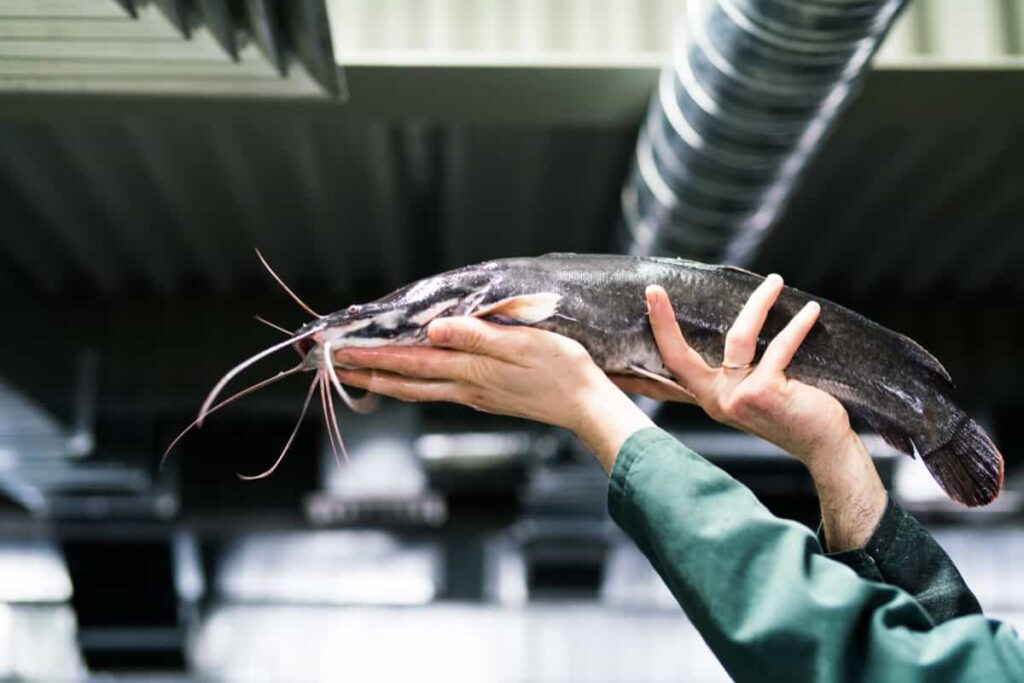
Feed Management in RAS Fish Farm
Proper feed management ensures the fish receive the nutrients for growth and development. Fish farmers can promote healthy growth, efficient feed utilization, and overall profitability in a RAS fish farming operation by using high-quality, species-specific feeds and providing appropriate feeding quantities and frequencies.
- High-quality feed: Use a high-protein feed that contains all the minerals and vitamins necessary for the fish’s nutritional needs.
- Species-specific feed: Different fish species have specific dietary requirements. It is important to choose feed formulations tailored to the specific cultivated species.
- Feeding quantity: Feed the fish at a rate of 3-5% of their body weight, depending on the quality and protein content of the feed. Adjustments can be made based on the growth and appetite of the fish.
- Feeding frequency: More frequent feedings, preferably several times daily, can lead to better growth rates and improved feed conversion ratio. Regular and consistent feeding schedules are essential for optimal fish growth and health.
Project Report of RAS Fish Farming
RAS Fish Farm Cost and Profit Economics and Project Report
- Initial Investment: The cost of setting up a RAS fish farm can be higher compared to traditional pond-based systems due to the infrastructure required, such as tanks, filtration systems, and electrical installations.
- Operational Costs: Operating a RAS fish farm involves expenses like feed, electricity, water, labor, maintenance, and periodic equipment upgrades. These costs can differ depending on the scale of the operation and the species being cultivated.
- Revenue Generation: Profitability on a RAS fish farm comes from selling the harvested fish. The market demand, selling price, and production volume are crucial in determining the revenue potential.
- Risk Management: Like any business venture, RAS fish farming involves risks like disease outbreaks, market fluctuations, and environmental challenges. Adequate risk management strategies should be in place to mitigate these risks.
- Project Viability: Conducting a thorough project report is crucial for assessing the financial viability of a RAS fish farm. It involves estimating costs, projecting revenues, and conducting a comprehensive analysis to determine profitability and return on investment.
In case you missed it: A Guide to Sustainable RAS Fish Farming Practices
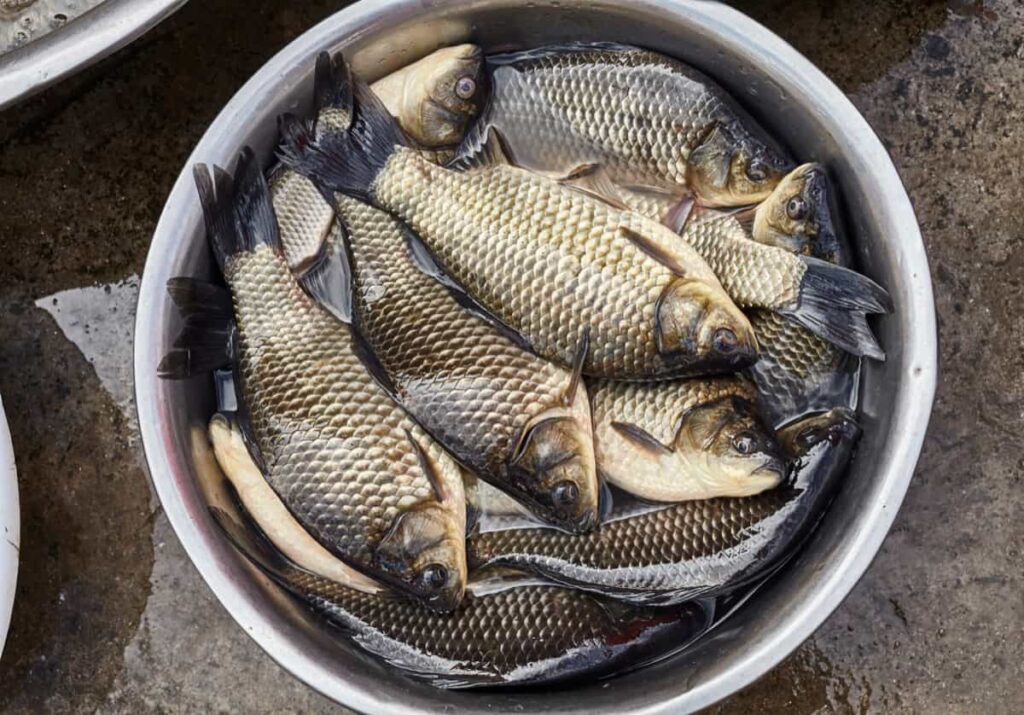
Cost of Production at the RAS Fish Farm
The cost of production at a RAS (Recirculatory Aquaculture System) fish farm, specifically for Nile Tilapia (GIFT), involves several components.
- Tank Size and Volume: The fish tanks used for Nile Tilapia (GIFT), in this case, have a size of 6.7m x 6.7m x 2m, with a total volume of 90 m3.
- Stocking Size and Density: Fingerling-sized Nile Tilapia (GIFT) with a stocking density of 6000 fish per tank.
- Survival Rate: A survival rate of 90% of the stocked fish survives throughout the culture period.
- Feed Conversion Ratio (FCR): The feed conversion ratio is 1:1.3, indicating that it takes 1.3 kg of feed to produce 1 kg of fish.
- Culture Period: The culture period or crop duration for Nile Tilapia (GIFT) is six months.
- Cost of Seed and Feed: Each fingerling (seed) costs Rs. 4, while the feed cost is Rs. 30 per kilogram. The total feed required for the culture period is estimated to be 3.51 metric tons (MT).
- Size at Harvest and Expected Biomass: Nile Tilapia (GIFT) is expected to reach a size of 500g at harvest, with an estimated total biomass of 2.7 MT.
- Sale Price: The expected sale price for Nile Tilapia (GIFT) is Rs. 140 per kilogram.
| Sl. No. | Components | Amount (Rs. in lakh) |
| A | Capital Cost | |
| 1 | Fish Tank Construction | 1.50-1.75 |
| 2 | Procurement & installation of pumps, filters, aerators, pipes, valves, etc. | 4.50-5.00 |
| B | Input Cost | |
| 1 | Seed (4500 fingerlings @ Rs.4/each) | 0.18-0.20 |
| 2 | Feed (28-30% protein; floating pellets) | 0.77-0.82 |
| 4 | Probiotics | 0.05-0.10 |
| 5 | Electricity | 0.40-0.45 |
| 6 | Miscellaneous | 0.10 |
| 7 | Total Cost (A+B) | 8.42 |
In case you missed it: Sustainable Fish Farming: Zero Waste Fish Farming Practices
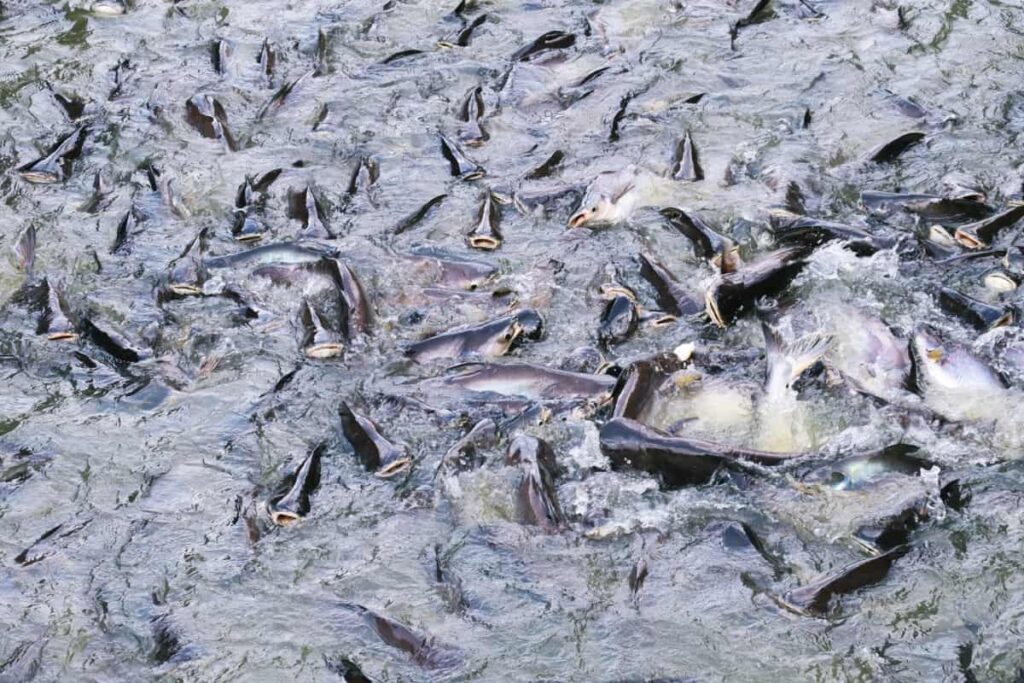
Cost of Production of Fish In RAS Fish Farming
- Total Capital Cost: Rs. 1.75 lakh + Rs. 5.00 lakh = Rs. 6.75 lakh
- Total Input Cost: Rs. 0.20 lakh + Rs. 0.82 lakh + Rs. 0.10 lakh + Rs. 0.45 lakh + Rs. 0.10 lakh = Rs. 1.67 lakh
- Total Cost (A+B): Rs. 6.75 lakh (Capital Cost) + Rs. 1.67 lakh (Input Cost) = Rs. 8.42 lakh
Profitability and Economic Feasibility of RAS Fish Farm
- Total Cost (A+B): Rs. 8.42 lakh (Capital Cost + Input Cost)
- Gross income from the 1st crop: Rs. 4.78 lakh
- Gross income at the end of the 1st crop after deducting recurring cost for the 2nd crop: Rs. 3.28 lakh
- Gross income from the 2nd crop: Rs. 4.78 lakh
- Gross income at the end of the 2nd crop: Rs. 11.06 lakh
- Depreciation cost at 15% of the capital cost: Rs. 0.90 lakh
- Net Profit = Gross income – Total Cost (A+B) – Depreciation cost
- Net Profit = Rs. 11.06 lakh – Rs. 8.42 lakh – Rs. 0.90 lakh
- Net Profit = Rs. 1.74 lakh
Net Profits indicate that the RAS Fish Farm has shown profitability and economic feasibility, with a positive net profit. Costs May vary depending on market conditions, operational efficiency, and other production costs.
How to Avail Subsidy in RAS Fish Farming
Submitting the Project Report (PR): The beneficiary must submit a project report and required documents, including proof of land availability (owned or registered lease document), to the concerned District Fisheries Office for further processing. In the case of leased land, a registered lease document for seven years from the submission date of the Self-Contained Proposal is required.
Self-Contained Proposal (SCP): The beneficiary must prepare a Self-Contained Proposal with full justification and technical-economic details, including the species/variety to be cultured, capital cost, and recurring costs involved. The project report should also provide information on anticipated employment generation, fish production enhancement, specific project implementation timelines, etc. This proposal needs to be furnished to the District Fisheries Office.
Restriction on Governmental Assistance: Governmental assistance for subsidies will be limited to one large, one medium, or one small RAS unit for an individual beneficiary. For a group of fishers and fish farmers, assistance will be limited to two large, three medium, or four small RAS units per group or society. However, a cluster or area may have multiple groups or societies. The concerned authority will decide the implementation modalities and upper ceiling for total eligible area support for FFPOs/Cs.
In case you missed it: Fish Hatchery Business Plan: How to Start, Cost, Profits, and a Great Way to Make Money
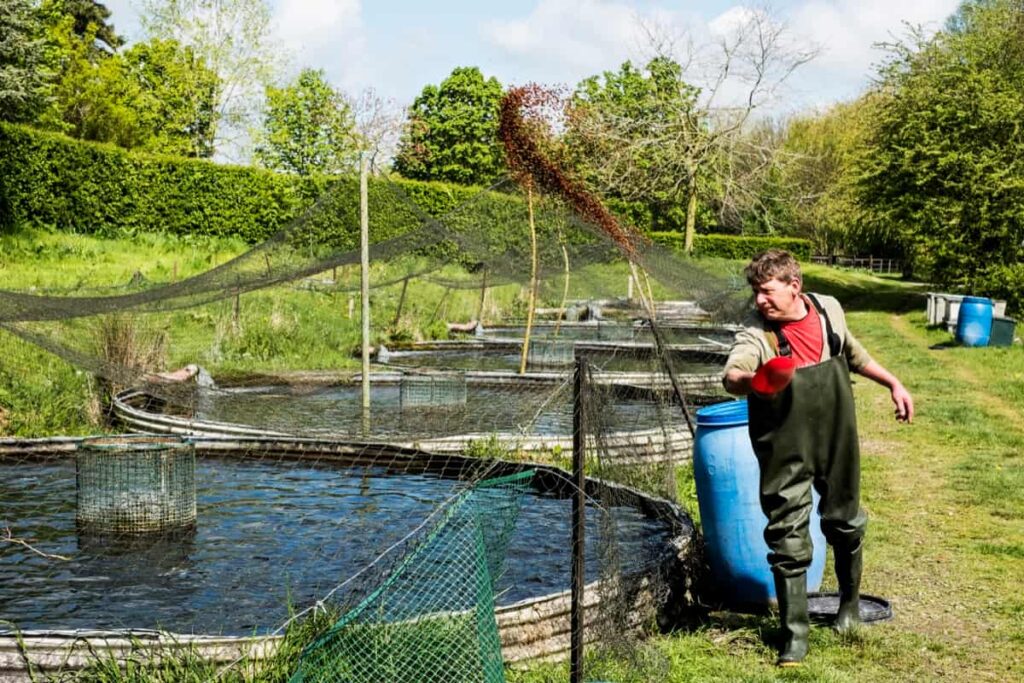
Availing subsidies for RAS fish farming requires proper documentation, including the project report and justification for technical and economic aspects. The restrictions on governmental assistance aim to ensure the equitable distribution of subsidies among beneficiaries. It is important to adhere to the guidelines and procedures set by the District Fisheries Office and other relevant authorities to avail of the subsidy successfully.
Conclusion
Conducting a cost and profit analysis for a RAS fish farm is needed to assess the venture’s economic feasibility and profitability. A well-prepared project report and accurate financial evaluation are essential for making informed decisions and maximizing returns.
- Crops Grown in Summer Season: Best Choices for Summer Gardening
- Organic Pest Control for Tomato Farming
- How to Maximize Sheep Farming Profit
- Broccoli Varieties: Choosing the Right Cultivars for Your Farm
- How to Raise Pigs in Your Own Backyard: A Comprehensive Guide
- Budget Friendly Sheep Shed Ideas: Cheap and Low-Cost Tips
- How Much Do Cattle Farmers Make: Revenue Streams in Cattle Farming
- Management Pests and Diseases in Your Cotton Field
- Sheep Farming Business Plan for Beginners
- Aquaponic Farming at Home: A Step-By-Step Guide
- Profitable Village Farming Business Ideas in 2024
- High-Yield Aquaculture: Fast-Growing Fish for Farming
- Effective Fish Pond Construction Techniques for Beginners
- Irrigation and Water Management in Pineapple Farming
- Blossom to Harvest: Mastering Flowering and Pollination in Papaya Farming
- Pig Fattening Essentials: From Selection to Sale for Beginners
- Raising Wagyu Cattle: A Complete Guide for Premium Beef Production
- Soil Types and Their Water Holding Capacity
- Optimizing Irrigation Schedules for Coconut Groves for Enhanced Yield
- Espresso Your Garden: Coffee Grounds for Healthier Acid-Loving Plants
- The Best Soil Mix for Snake Plants: How to Mix Your Own Snake Plant Soil
- Green Thumb Success: Expert Tips for Cultivating Greenhouse Beans All Year Round
- Bloom All Year Round: The Ultimate Guide to Indoor Hyacinth Care
- Eco-Friendly Gardening: How to Make Liquid Fertilizer from Kitchen Waste
- Ultimate Guide to Grow Anise in Pots: Explore Seed Propagation to Harvesting
- Guide to Raising Chester White Pigs: Discover Breed Facts to Growth Management
- Mastering the Elegance: The Ultimate Guide to Weeping Cherry Tree Care, Planting, and Maintenance
- Ultimate Guide to Planting Garlic in Grow Bags: Growing Strategies for Beginners
- How to Fix Spider Plant Leaf-Related Problems: Natural and Organic Remedies
- 10 Reasons Why Your Tulsi Plant is Shedding Leaves: Home Remedies and Solutions
- Optimizing Growth and Yield: The Advantages of Palm Bunch Ash Fertilizer
- Utilizing Neem Oil Extract as a Natural Pesticide for Hydrangea
- From Soil to Harvest: Various Ways in Which Farmers Can Use AI Tools
- Steps to Encourage and Induce Citrus Flowers: A Comprehensive Guide
- How to Fix Snake Plant Leaf-Related Issues: Natural and Organic Remedies
- Transform Your Garden into a Fragrant Oasis with Raat Ki Rani (Night Blooming Jasmine)
